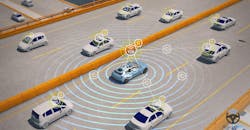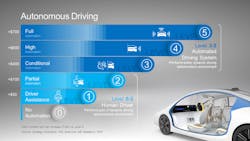Despite the controversy, the automotive industry continues to invest heavily in autonomous vehicles. Most of the discussion on the technologies used in developing an autonomous vehicle center around three types of sensors: camera, radar, and LiDAR. But another wireless technology that already exists can bring significant added value to autonomous cars: vehicle-to-everything (V2X).
V2X technology allows vehicles to communicate with each other, the infrastructure, and vulnerable road users, making driving safer and more efficient for everyone. By turning the invisible visible, V2X warns the driver of road hazards, helping reduce traffic injuries and fatalities. In addition to improving safety, V2X helps to optimize traffic flow, reduce traffic congestion, and lessen the environmental impact of transportation.
Why V2X for Autonomy?
There are five levels of autonomous driving, each providing more autonomy as they progress from one level to the next (see figure). To advance between these levels, an increasing amount of sensory data is necessary to enable the vehicle to make the right decisions.
Many new vehicles utilize the entire sensor suite of a camera, radar, and LiDAR for autonomous functions. These advanced safety systems can “see” what’s around a vehicle, exposing blind spots and nearby hazards. With radar and camera processing technology, vehicles can automatically steer and brake a vehicle to safety if a driver is slow or unable to react. Given the physical nature of these technologies, they sense only line-of-sight objects and events.
But what if a vehicle could “see” even further than what’s nearby—around curves, around other vehicles, through the dense urban environment, and even up to a mile away? With V2X technology, cars can “talk” to one another including motorcycles, emergency vehicles, and infrastructure including traffic lights, digital road signs, and pedestrians, even if they’re not directly within direct line of sight.
- Vehicle-to-vehicle (V2V) communications support safety systems with non-line-of-sight and latency-sensitive collision-avoidance capabilities—benefitting drivers, passengers, bikers, and others sharing the road.
- Vehicle-to-infrastructure (V2I) communications apply to a variety of safety and interactivity applications, including signage for road-related information, traffic-signal phase timing for emissions control and reduced congestion, and traffic-light communication to ensure that vehicles travel through intersections safely.
DSRC vs. C-V2X
There are two communication standards to support V2X: dedicated short-range communications (DSRC) based on 802.11 p and cellular V2X. DSRC allows the automatic transmission of real-time short, dedicated safety-critical messages between objects in the absence of a cellular network. Cellular-based V2X requires the assistance of a network. For safety-critical applications that must be able to operate in the absence of a network, DSRC is the ideal solution.
Low Latency and Non-Line-of-Sight Awareness
DSRC is the only proven and production-ready technology today that can reliably see around corners. This version of V2X delivers minimum latency for real-time communication and an operating range that exceeds one mile, even in areas where cellular network connections are not available. DSRC also provides dedicated secure safety channel operation to enable the secure communication of safety messages and other data in real time, forming an essential part of the suite of autonomous driving sensors for today's connected vehicles.
Significant investments are underway to guarantee the quality and reliability of this V2X technology. Several semiconductor companies have designed and tested automotive-qualified DSRC-compliant products. Many hardware and software products are available from multiple suppliers, comprising a rich ecosystem. Finally, there are several models in production today that incorporate DSRC technology, with others expected to launch soon, including models from Volkswagen, GM, and Toyota.
As the industry continues to make advances in autonomous driving, V2X should not be overlooked as an integral technology. The additional set of information provided by V2X can improve the quality of decisions taken by the central processing unit of an autonomous car, helping to make vehicle autonomy safer for everyone.
Rob Hoeben is the Senior Director of the V2X Segment within NXP Semiconductors’ Business Line Car Infotainment & Driver Assistance.
About the Author
Rob Hoeben
Senior Director, V2X Segment, Business Line Car Infotainment & Driver Assistance
Rob Hoeben is the Senior Director of the V2X Segment within NXP Semiconductors’ Business Line Car Infotainment & Driver Assistance. In this role, Rob is responsible for the management of the company’s modem system for vehicle-to-everything (V2X) communications. Over his 22-year career, Rob has held leadership positions in several innovative, high-growth businesses in automotive, mobile handset, and industrial markets.
Rob joined NXP from Ampleon, where he was the VP & GM of the Business Unit Multi Market & RF Energy. In a previous role at NXP, Rob was integral in the creation of the Automotive Ethernet business, including the founding of the OPEN Alliance. Rob holds a B.S. (cum laude) in Electrical Engineering and is a Six Sigma Black Belt.


